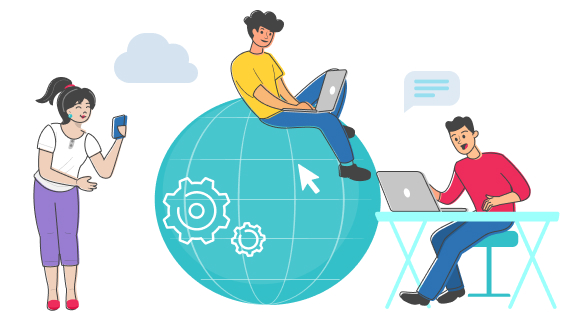It is impossible to deny how fast information technology (IT) has grown in the past decades. But we must ask ourselves: How does this technological development affect individuals’ rights? Can technology help to improve the exercise of human rights? As a matter of fact, technology has always been present in societies around the world, with the objective of improving people’s living standards. In that sense, if we understand human rights to be a set of ethical requirements of particular importance to individuals, then technology would of course have to focus on these in order to improve living standards.
These concepts are further developed in a series of 4 articles, of which this is the first
In this first approach, we intend to present a brief analysis of what is the place of technology in the dynamics of society. In the following, we will begin to deepen our understanding of its relationship to human rights, concluding with a practical experience in Nicaragua. Thus, we invite you to join us on this journey.

What do we understand by technology?

The past decades have seen a high advancement of technology. Most often, when the media speak of the influence of technology in our lives, they refer to new technologies or high-technology, to the extent that we ourselves, upon hearing the word technology, tend to think of last-generation computers, spacecraft, satellites, nuclear plants etc.
However, as pointed out by the Center for Innovation and Development of Remote Education (CIDEAD):
“the most commonplace, everyday objects are also technological products: books, clothes, pens haven’t always been as they are, they emerged from a discovery or an invention at one point in history. They too were, at one time, state-of-the-art technology”. [1]
In this sense, we can say that technology has evolved alongside mankind ever since the first cultures, and even before. In the Paleolithic period the first technological advancements were made, with the advent of stone tools and the discovery of how to start fires. For this reason, technological activity, our curiosity about modifying our surroundings in order to improve our living conditions, is as old as mankind itself.
This short review allows us to identify one characteristic of technology, indeed its goal: to modify our surroundings in order to improve our living conditions. In other words, technology’s objective is to improve the development of goods, processes and/or services that allow us to satisfy our human needs. In fact, the World Bank maintains that “technology is at the very heart of human progress and development. It accounts for much of the economic and social progress of the past few centuries. And it will help meet the environmental challenges of the twenty-first century”. [2]
Thus, technology can contribute to a better human understanding. But we must bear in mind that it can also be used for the exact opposite (it is worth remembering that the arms race is also a result of technological development). For this reason, in these articles we will suggest a link between human rights and technology, considering the former as a guide to focus the process of technological development on socially beneficial objectives.
Information and Communication Technologies

If we follow the story of technological advancement, in the past decades we’ve seen an emergence of new technologies, among them Information Technology (IT)[3]. This technology has gained a lot of importance worldwide owing to its ability to continuously alter our social and economic environment. According to Spence (2011), as quoted by the Foundation for Education and Development, the economic impact of computer-based networks has developed along three overlapping trends:
- The automation of information and data processing,
- The migration of many data acquisition and processing activities to the Web, and
- An immediate access to valuable human resources (friends and relatives, business partners, work colleagues, etc), regardless of their location, along with the ability to use them in market processes and to put together production chains in a global economy.[4]
Regarding Spence’s analysis, one can also identify impact in the social area, in politics and in institutional operations. As such, this kind of technology has allowed:
- Automated and immediate data generation and processing, which allows us to have adequate information for social purposes or political decisions.
- The democratization and transparency of access to information for society in general through the use of Web platforms, which allows most of the population to create studies and propositions.
- Increased fluency in communication between various work and social networks, helping with institutional or personal coordination and with the elaboration of more agile processes thanks to the cutting down of distances and time delays.
Having said that, in an attempt to measure the high growth of IT, Google published figures in 2012 in which one can see the increase in data generated on the Internet each month, from 1 petabyte per month in 1995 to 27,483 petabytes per month in 2011.[5] These figures also show the increase in Internet users, from 100 million in 1996 to 2.27 billion in 2011, roughly one in three people on the planet.[6]
These are significant data in which it is evident that technology -currently- impacts on many facets of society and human life; a situation that by 2020 is estimated to have grown in geometric progression, considering the strong impulse that these technologies had due to the pandemic context that the entire world is experiencing.
How can these technologies really help social services? and Are they related to human rights? The answer is “yes”, we invite you to read the following articles where we will delve into these issues.
